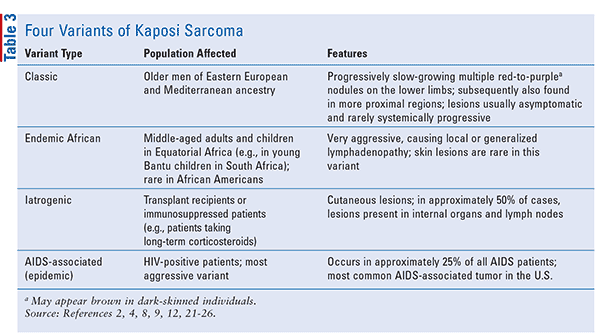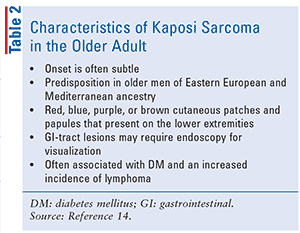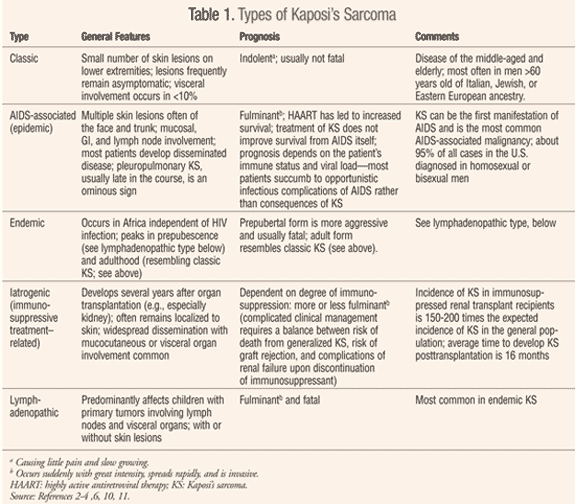In this insightful guide, you will explore the world of Kaposi’s Sarcoma, a rare form of cancer that primarily affects individuals with compromised immune systems. We will delve into the various risk factors associated with this disease, providing you with a comprehensive understanding of the potential triggers that could increase your susceptibility. Furthermore, we will also shed light on the diagnosis process, equipping you with the knowledge to recognize the early signs and seek prompt medical attention. By the end of this article, you will feel empowered with the information necessary to navigate the world of Kaposi’s Sarcoma with confidence.

What is Kaposi’s Sarcoma?
Definition and Overview
Kaposi’s Sarcoma (KS) is a rare and complex form of cancer that affects the cells lining blood vessels, resulting in abnormal growths or tumors. These tumors can develop on the skin, mucous membranes, lymph nodes, and internal organs. The disease is caused by a viral infection known as human herpesvirus 8 (HHV-8) or Kaposi’s sarcoma-associated virus (KSHV). It primarily affects individuals with weakened immune systems, including those living with HIV/AIDS.
History and Origins of the Disease
The disease was named after Moritz Kaposi, a Hungarian dermatologist who first described the characteristic skin lesions in 1872. Kaposi’s Sarcoma has been recognized for centuries, but it gained significant attention during the AIDS epidemic in the 1980s when it was observed as one of the opportunistic infections associated with HIV infection. Further research led to the identification of the HHV-8 as the underlying cause of Kaposi’s Sarcoma.
Risk Factors
Human Immunodeficiency Virus (HIV) Infection
Individuals infected with HIV have a significantly higher risk of developing Kaposi’s Sarcoma. The immune system’s weakened state in HIV/AIDS patients allows the HHV-8 to propagate and cause the development of tumors. The risk is particularly high in individuals with a low CD4 cell count, a key component of the immune system.
Weakened Immune System
Besides HIV infection, other conditions or medical treatments that compromise the immune system can increase the risk of Kaposi’s Sarcoma. These include organ transplants, certain autoimmune disorders, long-term corticosteroid use, and chemotherapy drugs used for other cancers.
Organ Transplant Recipients
Patients who have undergone organ transplant procedures, particularly when using immunosuppressive drugs to prevent organ rejection, have an elevated risk of developing Kaposi’s Sarcoma. The suppression of the immune system makes these individuals susceptible to HHV-8 infection and subsequent tumor development.
Age
Though Kaposi’s Sarcoma can occur at any age, it is more commonly diagnosed in older adults. The risk increases with advanced age, and the reasons behind this association are not yet fully understood. Some studies suggest that the aging immune system may have a reduced ability to control HHV-8 infection, leading to tumor growth.
Geographic Location
The incidence of Kaposi’s Sarcoma varies across different geographic regions. It is more prevalent in Mediterranean countries, sub-Saharan Africa, and areas with a higher prevalence of HIV infection. This suggests that environmental factors and regional variations in HHV-8 transmission may play a role in the disease’s occurrence.

Types of Kaposi’s Sarcoma
Classic (Mediterranean) Kaposi’s Sarcoma
Classic KS primarily affects elderly men of Mediterranean or Eastern European Jewish descent. It usually presents as skin lesions on the lower limbs, but it can also involve the lymph nodes and internal organs. Classic KS progresses slowly, and its association with HHV-8 infection is less pronounced than other forms.
Endemic (African) Kaposi’s Sarcoma
Endemic KS is primarily seen in equatorial Africa, where it affects children and young adults. This form of KS is more aggressive and tends to involve multiple organs, including lymph nodes, gastrointestinal tract, and lungs. Its association with HHV-8 infection is very strong.
Immunosuppressive Therapy-related Kaposi’s Sarcoma
This type of KS develops in individuals receiving immunosuppressive therapy after an organ transplant or to manage autoimmune disorders. These medications enable HHV-8 to reactivate and cause the development of KS. Immunosuppressive therapy-related KS can affect the skin, mucous membranes, and internal organs.
Epidemic (AIDS-related) Kaposi’s Sarcoma
AIDS-related KS occurs in individuals living with HIV/AIDS when their immune system is severely compromised. It typically affects the skin and mucous membranes, but the internal organs may also be involved. This form of KS can be aggressive and progress rapidly. It was one of the first signs of AIDS in the early years of the epidemic.
Signs and Symptoms
Skin Lesions
The most common initial sign of Kaposi’s Sarcoma is the development of skin lesions. These lesions can vary in appearance, ranging from flat, reddish-purple patches to raised nodules or tumors. They are usually painless and may occur on the legs, face, trunk, or genital area. Over time, the lesions may grow in size or number.
Internal Organ Involvement
Kaposi’s Sarcoma can affect internal organs, such as the lungs, gastrointestinal tract, and lymph nodes. When these organs are involved, symptoms may include coughing, shortness of breath, chest pain, difficulty swallowing, abdominal pain, and swelling of the lymph nodes. These symptoms depend on the location and extent of the tumor growth.
Lymphedema
In some cases, Kaposi’s Sarcoma can cause lymphedema, which is swelling in the arms or legs due to the accumulation of lymph fluid. This occurs when the tumor growth obstructs or damages the lymphatic vessels. Lymphedema can cause discomfort, heaviness, and a feeling of tightness in the affected limbs.
Other Possible Symptoms
Depending on the subtype and extent of Kaposi’s Sarcoma, additional symptoms may include fatigue, night sweats, unexplained weight loss, and fever. Cases with widespread organ involvement may lead to complications such as bleeding, breathing difficulties, or organ failure.

Diagnostic Tests
Physical Examination
A healthcare professional will conduct a thorough physical examination to assess the extent and characteristics of skin lesions or potential internal organ involvement. They will also inquire about the patient’s medical history and risk factors to consider Kaposi’s Sarcoma as a possible diagnosis.
Biopsy
A biopsy is the definitive method to diagnose Kaposi’s Sarcoma. It involves the removal of a small sample of tissue from a skin lesion or affected organ for laboratory analysis. The biopsy helps determine the presence of abnormal blood vessels, infected cells, and confirm the presence of HHV-8.
Imaging Tests
Imaging tests, such as X-rays, CT scans, MRI scans, or PET scans, may be performed to evaluate the extent of the disease and determine if internal organs are involved. These tests provide detailed images that can help guide treatment decisions and assess disease progression.
Laboratory Tests
Laboratory tests, including blood tests, may be conducted to assess the patient’s overall health and aid in the diagnosis of Kaposi’s Sarcoma. These tests may include a complete blood count, liver function tests, kidney function tests, and detection of viral antibodies or DNA.
Staging and Prognosis
Stage I: Localized Disease
In stage I, Kaposi’s Sarcoma is confined to the skin and/or lymph nodes in one area of the body. The tumors are limited in size and number, and there is no significant involvement of internal organs. With appropriate treatment, the prognosis for stage I KS is generally favorable.
Stage II: Disseminated Disease
Stage II KS involves multiple areas of the skin and/or lymph nodes, and there may be limited involvement of internal organs. The tumors may be larger in size and greater in number. Treatment can still be effective, but the prognosis may vary depending on the extent of disease progression and the patient’s overall health.
Stage III: Advanced Disease
Stage III KS signifies widespread involvement of the skin, lymph nodes, and internal organs. The tumors are numerous and may be quite large. Treatment options may be limited, and the prognosis is generally less favorable. However, advancements in supportive care and management have improved outcomes for some individuals.
Prognosis and Survival Rates
The prognosis for Kaposi’s Sarcoma varies based on multiple factors, including the subtype, stage of disease, overall health, and the effectiveness of treatment. Early diagnosis and appropriate treatment can significantly improve outcomes. However, the disease can be aggressive in certain subtypes or in individuals with advanced HIV infection. Regular follow-up care is essential to monitor the response to treatment and manage potential complications.

Treatment Options
Antiretroviral Therapy (ART)
For individuals with HIV-related Kaposi’s Sarcoma, antiretroviral therapy is a crucial component of treatment. By suppressing the HIV virus and improving immune function, ART can help control the growth and progression of Kaposi’s Sarcoma. It may also lead to regression or stabilization of existing lesions.
Chemotherapy
Chemotherapy drugs can be used to treat Kaposi’s Sarcoma, especially in cases where the disease is more advanced or has spread to internal organs. Various chemotherapeutic agents can be utilized, either individually or in combination, to target the rapidly dividing cancer cells. Side effects may occur, but they can often be managed with supportive care.
Immunotherapy
Immunotherapy options, such as immune checkpoint inhibitors, may be considered for certain patients with advanced Kaposi’s Sarcoma. These treatments help stimulate the immune system to fight against the cancer cells. Although not suitable for all cases, immunotherapy can provide promising results in specific situations.
Radiation Therapy
Radiation therapy uses high-energy X-rays or other sources of radiation to target and destroy cancer cells. It can be effective in treating localized skin lesions or relieving symptoms caused by tumor growth in specific areas. Side effects are generally temporary and can include skin irritation, fatigue, and changes in skin pigmentation.
Surgery
Surgical interventions may be necessary in specific cases of Kaposi’s Sarcoma. This can involve the removal of tumors from the skin, excision of affected lymph nodes, or resection of tumors in internal organs. Surgery aims to remove or reduce tumor burden and improve quality of life. It is often combined with other treatment modalities.
Supportive Care
Supportive care plays a vital role in the management of Kaposi’s Sarcoma, as well as the overall well-being of individuals affected by the disease. This includes measures to relieve symptoms such as pain, controlling infections, managing lymphedema, and providing psychosocial support for patients and their families.
Prevention
Practicing Safe Sex
Engaging in safe sexual practices, such as using condoms and limiting sexual partners, can reduce the risk of acquiring or spreading HHV-8. This is particularly important for individuals at higher risk, such as those with HIV infection or engaging in sexual activity with individuals from regions with a higher prevalence of the virus.
HIV Prevention Measures
Preventing HIV infection is essential in minimizing the risk of developing HIV-related Kaposi’s Sarcoma. This includes practicing safe sex, avoiding sharing needles or other drug paraphernalia, and undergoing regular HIV testing. Individuals at risk should also consider pre-exposure prophylaxis (PrEP) and post-exposure prophylaxis (PEP) medications.
Regular Medical Check-ups
Regular medical check-ups, especially for individuals with a weakened immune system, can help detect Kaposi’s Sarcoma at an earlier stage. Routine screenings, including skin examinations and blood tests, can aid in the early identification of skin lesions or HHV-8 infection, allowing for timely intervention and treatment.

Support and Resources
Patient Support Groups
Joining patient support groups or organizations dedicated to Kaposi’s Sarcoma can provide valuable emotional support, information, and resources for individuals and their families. These groups often offer opportunities to connect with others facing similar challenges, share experiences, and access additional support services.
Online Resources
Numerous online resources provide comprehensive information about Kaposi’s Sarcoma, including reputable medical websites, research articles, and patient-focused organizations. These resources can help individuals stay informed about the disease, understand treatment options, and access the latest research developments.
Counseling Services
Counseling services, including individual therapy or support from mental health professionals, can assist individuals and their families in coping with the emotional impact of Kaposi’s Sarcoma. These services provide a safe space to address concerns, manage stress, and promote overall psychological well-being.
Clinical Trials
Participating in clinical trials may be an option for individuals with Kaposi’s Sarcoma, particularly those with advanced or refractory disease. Clinical trials explore new treatment modalities, medications, or approaches to improve outcomes, and participants may have access to cutting-edge therapies not yet available to the general population.
Conclusion
Kaposi’s Sarcoma is a complex and diverse disease that can present in various forms. It is predominantly associated with weakened immune systems, particularly those affected by HIV/AIDS or undergoing immunosuppressive therapy. Early detection and appropriate treatment are essential in managing the disease and improving outcomes. Practicing safe sex, seeking regular medical check-ups, and accessing supportive resources can contribute to prevention efforts and enhance the overall well-being of individuals affected by Kaposi’s Sarcoma. With ongoing advancements in research and medical interventions, there is hope for better outcomes and improved quality of life for those affected by this rare form of cancer.